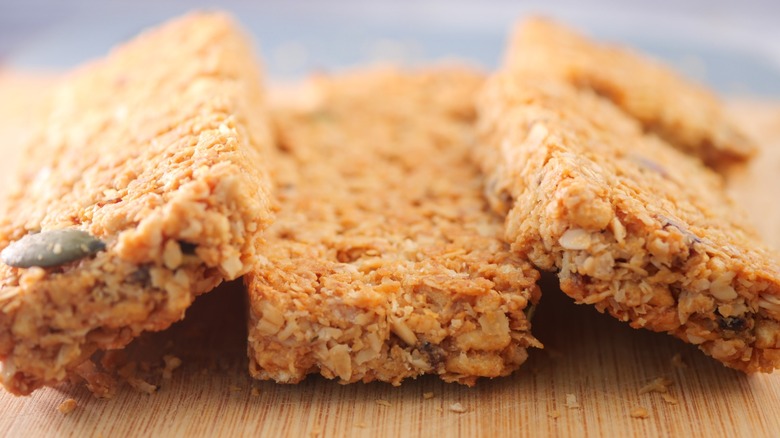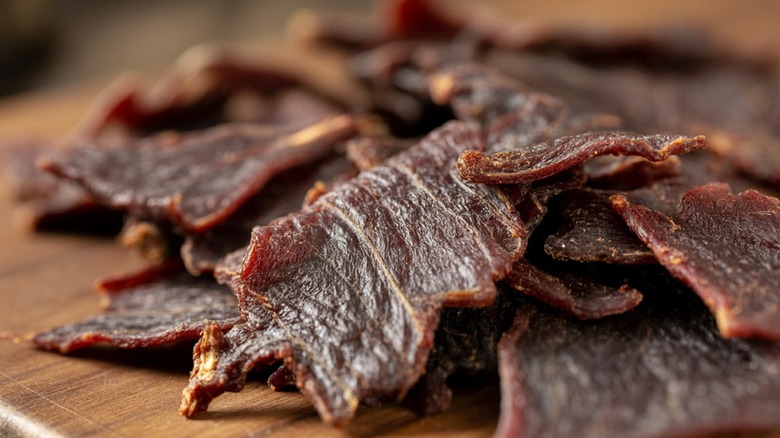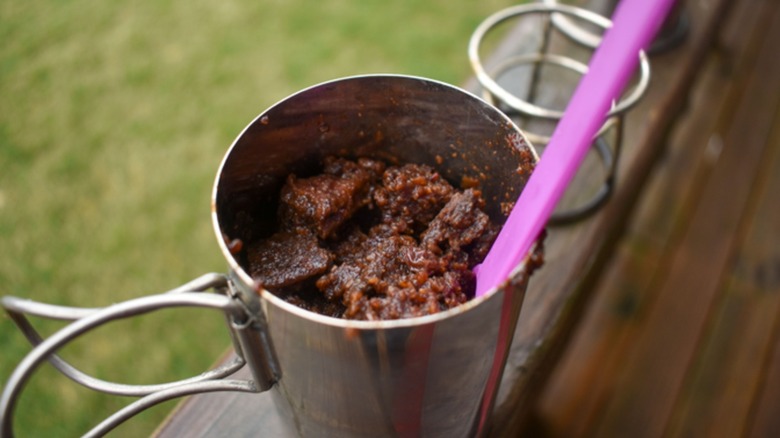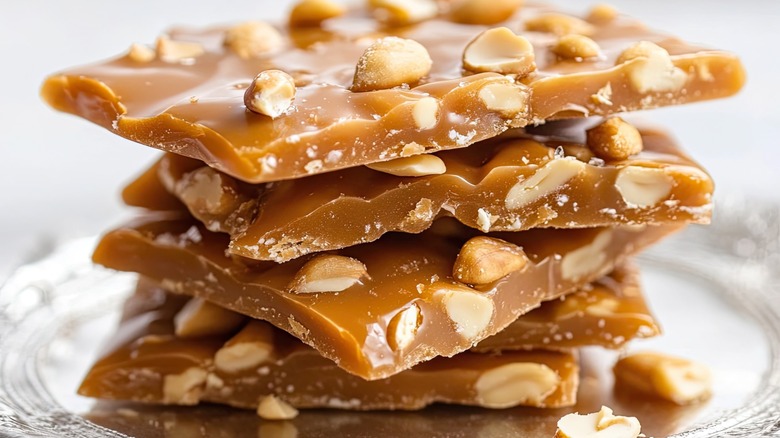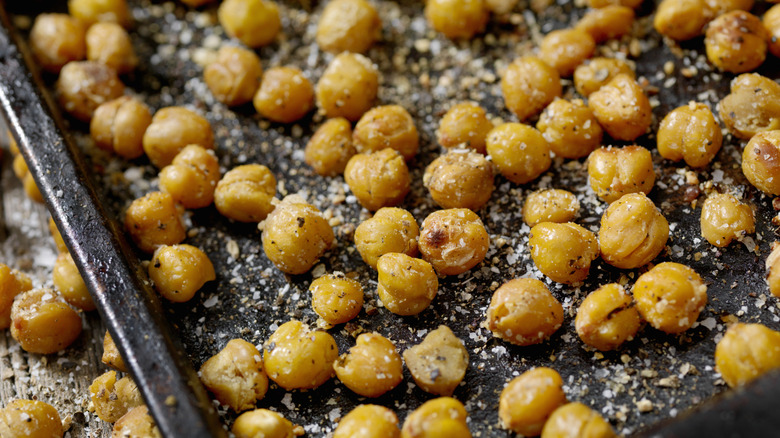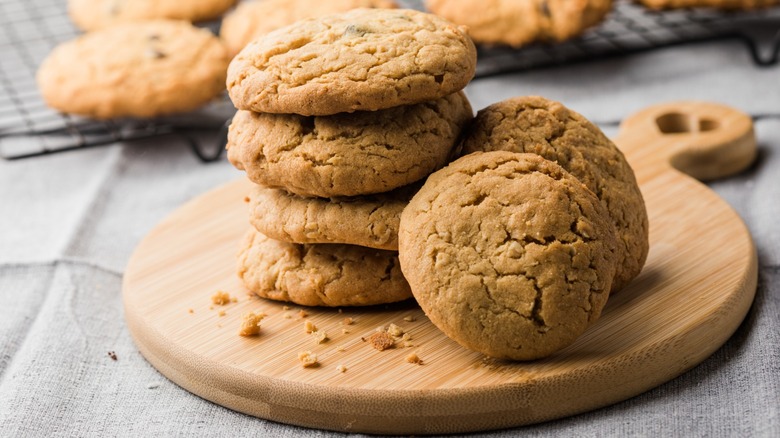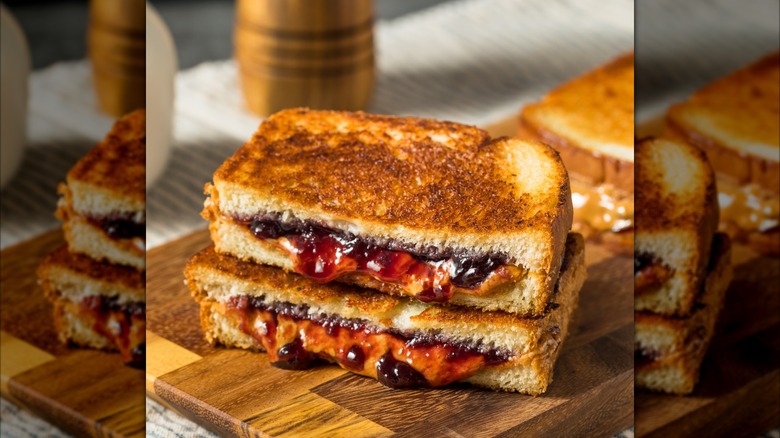The 13 Best Foods To Make In Preparation For A Winter Storm Emergency
When winter storms hit, it's not just the snow piling up outside that can stop you in your tracks. The dreaded power outage that sometimes follows these flurries can also prove especially worrisome. The fridge is down, the oven's no longer an option, and suddenly preparing dinner for you or your family feels like a puzzle you are attempting to solve with several missing pieces.
But not all is lost, and before you panic, take a breath and keep reading. With a little preparation (and a propane grill or camping stove), you can still eat well during a winter storm outage, even if the lights are out for days.
To make the most of a less-than-ideal kitchen situation, we've compiled this guide to staying fed, fueled, and maybe even a little spoiled during blizzards. The key is whipping up some foods beforehand (or when bad weather hits) that utilize shelf-stable ingredients and pantry staples. These snacks and meals won't even require the use of appliances that can blink and go off when the power does. So, grab your propane stove and get your rolling pin ready, as we plow through some storm-ready recipes that'll help you prepare for winter chill and potential outages.
No-bake energy balls
When the lights go out and your kitchen turns into a scene from "Little House on the Prairie," the last thing you want to do is stress about breakfast or snacks. That's where these no-bake energy balls come in clutch. You don't need an oven, a fridge, or even much equipment –– just a bowl, a spoon, and a few pantry staples. Rolled oats, peanut butter, and honey or maple syrup make up the sturdy, satisfying base.
From there, you can freestyle: add shredded coconut, flaxseed, chia seeds, or a scoop of protein powder for extra nutrition. Mix, roll, and you've got a bite-sized energy boost that's shelf-stable and storm-proof. These little orbs of comfort are perfect for mornings when you can't make eggs and bacon, or when you're running low on fresh food.
The best part is that they'll keep for days without refrigeration, so you can stash them in an airtight container and snack like a champ while the snow starts piling up outside. When the only power source is a candle and your sheer will to stay cozy, these no-bake bliss balls are just the thing.
Easy homemade biscuits
Few things feel as comforting as a warm, buttery biscuit. When you're facing a looming snowstorm, comfort becomes even more of a desire and necessity. Luckily, these easy three-ingredient biscuits prove that flaky perfection doesn't need a fancy kitchen setup to shine even amid an outage. With just self-rising flour, heavy cream, and butter, you can whip these up before the storm, then reheat them on a propane grill or in a covered skillet.
Think of it as camping, but better. These biscuits, once prepared, are hearty enough to stand in for dinner rolls, sandwich bread, or even breakfast when paired with a little shelf-stable honey or jam. They feel homey and make mealtime special, even when you're basically roughing it. Plus, they're an ideal companion for all those canned soups and stews you'll likely be heating up on your camping stove.
Make a big batch while the weather's still calm in the oven or stovetop skillet, and they'll stay fresh in an airtight container for a few days. Whether you're huddled under blankets or watching the snow fall by flashlight, a warm biscuit is sure to be a welcome, buttery luxury.
Homemade granola bars
For those times when snow continues to fall and the power's out, having long-lasting snacks is paramount. Homemade granola bars are a must and also double as one of the best breakfast meal prep dishes. Unlike some baked goods that need refrigeration, granola bars are built to stay fresh in an airtight container anywhere from a week to one month, depending on the ingredients.
The granola base is simple, consisting of oats, honey or syrup, and a binder like nut butter. From there, it's easy to get creative, using nuts, dried fruit, seeds, or even leftover snack mix that can all be folded in to enhance the flavor and make them more nutritionally diverse. That open-ended customization is part of the appeal. Every batch can taste slightly different, so you never get bored, even if you're relying on shelf-stable foods for days. You could even skip the bars and make loose granola for munching.
And speaking of versatility, granola isn't just for breakfast. It can also be a quick, sweet sidekick or semi-dessert when soup or chili is on the menu, or a post-shovel-sesh pick-me-up after clearing the driveway. When winter storms strike and the fridge is out of commission, having a handful of golden goodness or a stack of these bars ready is a wise (and delicious) decision.
Beef jerky
If you're bracing for a long winter blackout, beef jerky is the ultimate power-outage food. Shelf-stable, protein-packed, and ready to eat straight from the sealed pouch or jar, it's perfect for snacking or tossing into soups heated on the camping stove to add smoky flavor. This tender homemade beef jerky proves you can get a perfectly seasoned, chewy, and long-lasting snack without refrigeration.
Another perk to prepping this item yourself is that, by marinating your own jerky, you wield full control over the taste. Some intriguing flavor options that take jerky to the next level include soy sauce, brown sugar, garlic powder, smoked paprika, or even a hint of cayenne. Once dried, jerky can last in airtight containers for a couple of weeks (sometimes up to six months in ideal conditions) without refrigeration, making it an ideal "survival" item for those days when your regular indoor appliances are off-limits.
You can munch on it straight from the jar, toss it into a quick stir-fry on a camping grill, or pair it with shelf-stable crackers and cheese for a simple, satisfying meal. Think of jerky as the survival food that tastes like a treat.
Hoosh
When it comes to surviving the elements and feeling intrepid, hoosh is the ultimate winter-storm meal. This dish was inspired by the stews eaten by the famed Antarctic explorers Shackleton and Amundsen, and this hoosh recipe is surprisingly fitting for modern kitchens rendered without power.
Originally concocted from hardtack (a nearly immortal cracker) and pemmican (bars of jerky, fat, and dried fruits used by Indigenous peoples long before Europeans jumped on this particular arctic party bus), hoosh was the lifeline for those hauling through wintery terrain. It wasn't made for its good taste, but rather for its nutrient-dense offerings. Yet, it's actually thought by many to be pretty darn great when you make it yourself. And when you bring it all together, reheating it on your propane stove, you get to enjoy a rich, savory stew that eats like chili's (really) rugged cousin once removed.
It also combines all the food from your pantry that defies logic (and the need for refrigeration), laughing in the proverbial face of power outages. So grab your pot, light that camping burner, and channel your inner explorer. When you've got a bowl of hoosh steaming in front of you, winter (and its piddly little storm surges) don't stand a chance.
Vegan cheese spread
Flavorful and outrageously versatile, this homemade vegan cheese spread is a game-changer when winter storms are looming. Made with sauerkraut, nutritional yeast, and an optional handful of soaked cashews, this spread transforms even the simplest pantry staples into satisfying snacks. Slather it on crusty bread, pair it with crackers, or dunk raw veggies in it, and it's easy to see why this spread belongs on your storm-prep list.
Unlike traditional cheese spreads that spoil fast when a blizzard zaps the power to your fridge, this dairy-free version holds up longer and tastes vibrant for days. Online sources quote varying shelf-life estimates for sauerkraut, depending on whether it's homemade, store-bought, or pasteurized, but it may last from a week up to a month at room temperature when stored correctly. You can make a batch ahead of time, stash it in an airtight container, and pull it out whenever hunger strikes.
The tangy, creamy flavor gives a sense of comfort, even when the snow is piling high outside and the only heat is coming from your camping stove or wood-burning fire. This is one survival food that proves power outages don't have to mean bland eating.
Bannock
Bannock is one of those old-school breads you won't find at your local bakery. For centuries, Indigenous and settler communities relied on simple, shelf-stable breads like bannock for sustenance. Made from flour, water, and a bit of fat, this quick bread reheats beautifully on a propane stove or skillet held over a fire, making it ideal when your oven is out of commission. If the power outage caught you by surprise, you can even make this dish from scratch in a cast iron pan.
Bannock is incredibly versatile. Whether you tear it apart to scoop up stew, toast it, or enjoy it as a snack with some shelf-stable spreads, bannock is a banger. And just like the other items on our list, bannock doesn't require refrigeration, which makes it a pantry hero during winter hellscape weather. When kept in an airtight container, anecdotal evidence reveals that this bread has a shelf-life of over one month.
Amish Friendship Bread
If that dreaded snowstorm is threatening to knock you off the power grid and render your kitchen dependent on propane, it helps to take a page from the Amish playbook. One of many Amish foods you need to try, friendship bread is more than a delicious, doughy treat. It is an edible lesson in patience, resourcefulness, and enjoying good food without refrigeration.
This sweet, tender bread is made from a sourdough-like starter that thrives at room temperature. The starter is typically left to grow for 10 days. Once you've made a loaf, it's perfect for winter storms and could even be reheated or toasted on a propane stove or over a flame for a bite that's comforting, fragrant, and surprisingly hearty. Slice it for breakfast, enjoy it with nut butter, or snack on it cold while the wind howls outside. Like many baked goods, Amish friendship bread can last for a few days in a resealable plastic container at room temperature.
The beauty is that once you have the starter going, you can continue dividing and feeding it to keep it alive. Make several loaves in preparation for bad weather or share the starter with your neighbors who are facing the same winter doom. This pick is a useful solution for days when grocery runs (or refrigeration) aren't options.
Peanut brittle
Sweet, crunchy, and surprisingly long-lasting, peanut brittle is the ultimate no-refrigeration snack. When stored in optimal conditions (in a sealed container in a cool, dark, and dry spot), it can last for up to a few months. This makes it a lifesaver during a winter storm when fridge access is a no-go. Simple pantry ingredients , like sugar, peanuts, and butter, transform into a sticky, nutty, golden confection that keeps energy up and moods high, even when the weather outside is quite gloomy.
You can prepare a batch of peanut brittle in the microwave. Once it is cooled, break it into chunks and store it in a jar, ready for when the storm hits and it's time for a snack.
Nibble on it straight from the tin, crumble it over oatmeal you've whipped up over the campfire or camp stove burner, and you have a sweet, buttery treat with zero fuss or need for refrigeration. While it can last for a while, we have a sneaking suspicion this brittle won't be long for this world.
Fruit leather
If you're prepping for a doozy of a winter storm and concerned that the fresh fruit you have on hand will start to turn, fruit leather is a genius, long-term solution. It preserves the flavor, nutrition, and sweetness of ripe fruit in a chewy, shelf-stable form that's perfect for snacking during a blackout. Lasting long after regular fruit has ripened past its okay-to-eat date, fruit leather is good for up to one month kept at room temperature, according to the National Center for Home Food Preservation.
To make fruit leather, all you need is a little heat and a flat surface to dry the fruit puree. While many people use a dehydrator for the process, you can also do it in the oven. Once ready, roll it up or cut it into strips, making for a naturally sweet, vitamin-packed, no-refrigeration-needed snack.
Clearly, fruit leather is a no-brainer for storm preparedness. Pair it with nut butter, crumble it over granola, or enjoy it solo.
Crispy chickpeas
If you are looking for a powerhouse snack that delivers protein, crunch, and zero fridge dependence, consider preparing roasted chickpeas in the air fryer for your snowstorm MVP. These tasty little bites are hearty, flavorful, and perfect for munching on straight from a jar while you are stuck inside without electricity. No soggy fridge leftovers here, as crispy is the only acceptable texture for these shelf-stable snacks.
Seasoned however you like (smoky, spicy, or with classic salt), crispy garbanzo beans provide energy and fiber, keeping you full when the grocery store and refrigerator crisper are temporarily off-limits.
Store them in an airtight container at room temperature, and they'll stay crunchy and keep for a few days. You can even reheat the crunchy chickpeas on a skillet or camping stove, or add them as toppings to soups you're simmering on a propane burner, adding texture and protein to your meals.
Peanut butter cookies
Cookies that don't need refrigeration? Yes, please. These three-ingredient peanut butter cookies are quick, simple, and entirely shelf-stable, making them a perfect morale booster to sweeten things while weathering the winter storm. The basic recipe is gluten and dairy-free, which is a win when you want treats everyone can enjoy.
All you need is peanut butter, sugar, and an egg, and you can bake a batch in preparation for the dreaded day you hear that click, the lights go out, and you're suddenly rockin' it old school à la Laura Ingalls Wilder.
These cookies bake up soft, chewy, and irresistibly nutty, providing a sweet lift when electricity is out and options are limited. Store in an airtight container, and they'll stay fresh for days. According to the USDA, homemade cookies are actually shelf-stable for two to three weeks. That makes these perfect for grabbing on the go while shoveling snow or simply trying to stay warm indoors with a little snack.
PB&J, but make it fancy
PB&J might be the ultimate survival food, but even classics can quickly get boring. And who doesn't deserve a glow-up now and then, anyway? By day two or three living off grid, when that basic sammy just isn't hitting the spot, some of these tips for elevating peanut butter and jelly can help you turn that humble sandwich into a comfort-food superstar. Think grilled PB&J on a skillet or camping stove, swirled with honey, or topped with banana slices and a drizzle of melted chocolate chips for a sweet and exciting twist.
With just a few pantry staples and a little heat from your propane setup, a PB&J can quickly become a gooey, warm, and flavorful dinner, no fridge required. You can use shelf-stable nut butters, jarred jam, some homemade bread, and voila!
In a blackout, variety matters. Our fancy-pants PB&J can help keep spirits high, tummies satisfied, and provide a simple twist that turns a classic standby into a little culinary joyride.



